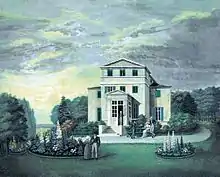Hellerupgård
Hellerupgård, namesake of the district Hellerup as well as the street Hellerupgårdsvej, is a former country house situated at Hellerupgårdsvej 20 in Gentofte Municipality north of Copenhagen, Denmark. The main building from 1802–03 was designed by the Hamburg-based French architectJoseph-Jacques Ramée. who also designed the still existing country houses Sophienholm, Øregård and Frederikslund. The building was demolished in the 1950s and Gammel Hellrup Gymnasium is now located on the site.

History
18th century
.jpg.webp)
The property was originally called Lokkerup. In 1748, it was acquired by stempelpapirforvalter ("stamped paper manager") Johan David Heller (-1845). Je changed its name to Hellerup, a name which would later be changed to Hellerupgård after the name Hellerup had been transferred to the area in which it was located. In 1758, Heller's widow sold the estate to the merchant John Brown.[1] He constructed a two-storey pavilion at the corner of present-day Strandvejen and Hellerupvej.[2]
20th-century

The estate was later acquired by konferensråd Erich Erichsen for whom a new main building was constructed in 1802–03 to designs by the French architect Jacques Remy. The British troops established their headquarters at Hellerupgård during the Battle of Copenhagen.[3] It was at Hellerupgård, on 7 September 1807, that general Ernst Peymann signed the Danish capitulation.[2]
Erichsen owned Hellerupgård until his death in 1837. In 1843, it was acqyured by pharmacist and property investor Lauritz Schmidt. He had the previous year sold the Dehn Mansion in Copenhagen and bought the property at Amaliegade 14. In 1834m ge aold the property and bought the Peschier Mansion in Copenhagen.[4]
Hellerupgård was later acquired by chamberlain Vilhelm Huth Krag. He died at Hellerupgård on 13 August 1878.
20th century redevelopment and demolishion
In 1887, Hellerupgård was acquired by timber merchant and farmer C .L. Ibsen for DKK 319,000. With his later acquisisions of Slukefter and Lille Mariendal, in 1778 and 1895, respectively, he had become the owner of almost all land in the eastern part of what is now Hellerup, from the Øresund coast in the east to Rygård in the east and from Hellerupvej in the north to Tuborg in the south. In the late 1880s, he started selling the land off at DKK2 per square alen for redevelopment with single-family detached homes.[1]
In 1903, Hellerupgård's main building was sold to chamberlain and colonel G. Wedell-Wedellsborg. He charged the architect Carl Brummer with the design of a demicircular extension on the east side of the building. His widow owned the property until 1950, when it was acquired by the Ministry of Education and demolished.[3]
List of former owners
- (1848-1853) Johan David Heller
- (1753-1758-) Heller's widow
- (1758-) John Brown
- (-1837) Erich Erichsen
- (1843-1845) Lauritz Schmidt
Further reading
- Nystrøm, Eiler: Fra Nordsjællands Øresundskyst, Copenhagen 1938, p. 56pp
References
- "Marievejs historie" (in Danish). marievej.dk. Retrieved 10 July 2022.
- "Freden i Hellerup" (in Danish). Jyllands-Posten. Retrieved 10 July 2022.
- "Ældre landsteder" (in Danish). Trap Danmark. Retrieved 10 July 2022.
- "Et hus i Amaliegade" (PDF). indenforvoldene.dk (in Danish). Retrieved 20 July 2022.